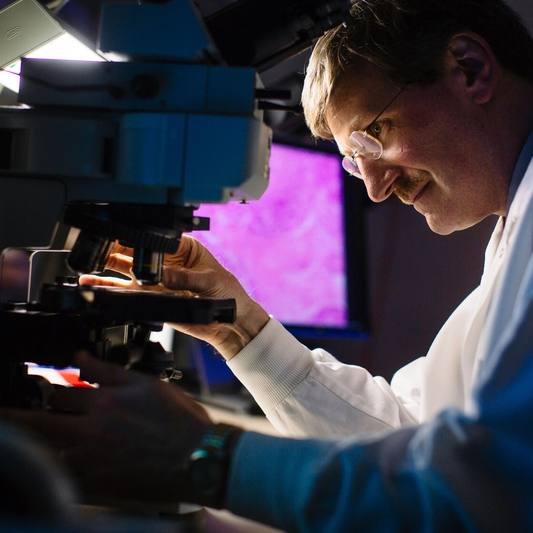-
Research
Can an ‘artificial pancreas’ normalize type 1 diabetes?
Russ Stephens is an insulin-dependent diabetic. Like thousands of other people with type 1 diabetes, he injects himself with insulin before every meal and again at bedtime. He also checks his blood glucose four or five times every day by pricking his finger to obtain a drop of blood that he tests using a compact hand-held glucose meter.
The blood glucose levels provide critical information that he uses to adjust his insulin dose, exercise schedule and food intake to maintain good diabetic "control," which is essential to reduce the likelihood of dreaded diabetic complications that can lead to blindness, kidney failure, nerve damage, heart attacks and strokes. Some people with diabetes prefer to use an insulin pump instead of the regular injections, but they still have to measure their blood glucose levels and adjust the rate of insulin infusion several times during the day.
"They set the alarm and wake up to check. Diabetes disrupts their sleep," says Ananda Basu, M.B.B.S., M.D., a Mayo endocrinologist. Unfortunately, even with the closest attention to detail, these conventional approaches can only approximate the perfect, real-

time blood glucose control that comes from having a normal pancreas.
That burdensome routine might someday be medical history. Mayo researchers will soon start clinical trials to evaluate an "artificial pancreas" — a device that can monitor blood sugar and deliver insulin in doses calibrated to the person's unique needs.
"This would be a seismic change in diabetes treatment," says Yogish C. Kudva, M.B.B.S., the Mayo endocrinologist who is leading the project along with Dr. Basu. "It is part of the quest for people with diabetes to lead a normal life."
How it works

Instead of finger pricks and dose calculations, the artificial pancreas uses an abdominal patch that continuously measures blood sugar and a pager-sized pump that delivers insulin beneath the skin. Mayo's major innovation is the sophisticated software algorithm, developed in consultation with Italian bioengineers, linking patch and pump.
"It will be loaded with information derived from the patient's own physiology," Dr. Basu says.
The result is a "closed-loop system," requiring limited input from the user. "It's all automated," Dr. Basu says. "The constant patient decision making is minimized."
Precise decisions are important because in type 1 diabetes, the pancreas produces little or no insulin. Abnormal blood sugar levels can lead to disabling and life-threatening complications, including heart attack, stroke, and damage to the nerves, eyes and kidneys. The artificial pancreas system might eventually be used to treat some people with type 2 diabetes, in which the body resists the effects of insulin.
Together, both types of diabetes affect about 24 million Americans. Diabetes is one of the biggest drivers of U.S. health care costs, with 1 out of 3 Medicare dollars spent on diabetes-related care. In partnership with the University of Minnesota, Mayo has launched a decade-long research effort to end diabetes.
The artificial pancreas is part of that endeavor. It's designed to replicate aspects of human metabolism, the complex process that converts energy from food into energy the body can use. Metabolism involves a host of factors — including the body's sensitivity to insulin and response to food and exercise — that vary widely among individuals and even within an individual at different times of the day. For women, menstrual and pregnancy hormones are added factors that influence sugar metabolism.
"There is tremendous variability in blood sugar levels day to day in a person with type 1 diabetes. This is why type 1 diabetes is notoriously difficult to manage," Dr. Basu says. He notes that within a single day, the blood sugar level of a person with type 1 diabetes can swing from 30 to 300 milligrams per deciliter (the normal range is 70 to 100 mg/dL). "This has a huge impact on patients' quality of life."
Incorporating that complexity into a manufactured device is an immense challenge and the culmination of years of research by Mayo scientists. Their laboratory discoveries about the physiology of metabolism are being factored into the artificial pancreas software algorithm.
Assessing physical activity
One critical set of variables involves physical activity. "Physical activity plays an important role in insulin action," explains James A. Levine, M.D., Ph.D., a Mayo endocrinologist. "Insulin dosing must be adjusted based on the amount of physical activity a patient does."
Dr. Levine leads a laboratory team whose work involves gauging people's total daily activity — not just calories burned at the gym, but every fidget and sedentary moment. "We've worked hard over many years to develop a series of technologies to measure very precisely how active or chair-ridden an individual has been," Dr. Levine says.
This ability to "capture" an individual's physical activity "was clearly Dr. Levine's brainchild," Dr. Kudva says. "Dr. Basu and I picked it up and realized the importance this had for developing the artificial pancreas."
As a result, the device incorporates measurements of physical activity and the individual's metabolic response. "To bring our bench science to real folks is an honor," Dr. Levine says. "It is a fantastic example of team building and, indeed, of the translation of lab discoveries to patient care."
Clinical trial
Mayo's commitment to patients and their unique needs is evident from the way the upcoming clinical trial is structured. Unlike other studies of insulin-delivery systems, which have relied on computer simulations to predict insulin needs, Mayo's trial will use real data from humans with type 1 diabetes. "The unique feature of our study is using information from patients to program the artificial pancreas," Dr. Kudva says. "This has not been done before at this scale."
In the first phase, people with type 1 diabetes will spend 40 hours in Mayo's Clinical Research Unit, an inpatient facility where study protocols can be strictly followed. The participants will be given precisely measured meals and have regulated exercise on a treadmill. This first stage is "open loop"; participants will use conventional methods to measure blood sugar and will decide, in consultation with Mayo physicians, how much insulin to take. Throughout this stage researchers will collect metabolic data from each study participant.
That data will then be fed into the artificial pancreas software algorithm. A few weeks later, the participants will return to the research unit and follow the same meal and exercise routine. But this time, each participant will use an artificial pancreas programmed with his or her unique metabolic information. "We will see how well this personalized closed-loop system controls blood sugar levels compared to the first visit," Dr. Basu says. He and Dr. Kudva hope to progress to an outpatient trial in 2014.
Collaboration at its best
The artificial pancreas highlights not only Mayo's metabolic expertise, but also the global reach of its research efforts. The software algorithm was developed by mathematicians in Italy who have collaborated with Mayo researchers for 25 years. "They are the world's leaders with regard to the mathematics of metabolism," Dr. Kudva says. "No one comes even close in this very specialized field," Dr. Basu adds.
Drs. Kudva and Basu, who occasionally finish each other's sentences, have collaborated on metabolic research for more than 15 years. They are close to finishing a study of whether insulin action varies by time of day. "If you have 100 grams of carbohydrates at breakfast, lunch and dinner, does it metabolize the same way?" Dr. Basu asks. The results of that research may provide yet another metabolic factor for the artificial pancreas software algorithm. "Mayo has the infrastructure to capture these complex processes accurately," Dr. Kudva says.
Indeed, that research infrastructure allows Mayo scientists to pursue the war against diabetes on a number of fronts. In addition to the artificial pancreas, Dr. Kudva is involved in Mayo's efforts to use adult stem cells to regenerate insulin-producing cells in people with type 1 diabetes. Dr. Kudva believes it's important to pursue different research paths simultaneously. "We provide more choices for patients with type 1 diabetes," he says.
Timing also is important, he adds. "Biologic solutions are sometime in the future. You could just wait, but that would be like going from a Turing computer to an iPad without doing anything in between. Whereas this translation of research into the artificial pancreas is happening as we speak."







